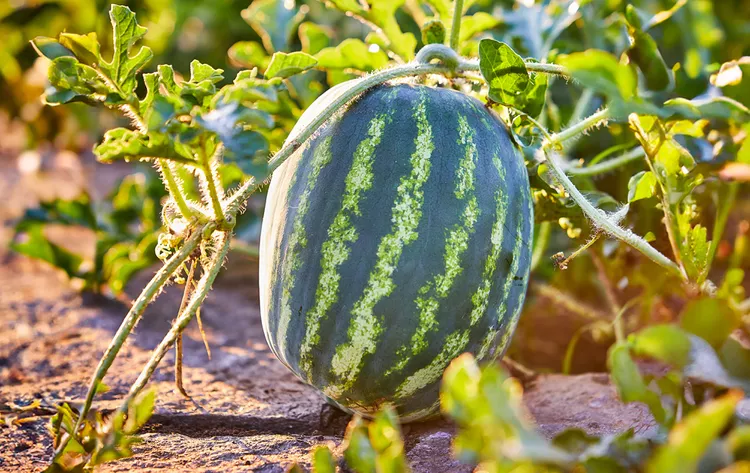How many watermelons per plant will grow depends on a number of factors such as variety, plant spacing, and available water. It also depends on what your goal is. If you want to grow a massive watermelon to show off at the county fair, removing extra fruits from the vine focuses the plant’s energy toward growing one big watermelon. But if you'd rather get as many watermelons per plant as possible, there are several things you can do to maximize the number of developing fruits. These tips will help you decide how many watermelons per plant to keep and show you how to grow the best melons with or without pruning.
How many watermelons per plant will you get?
Under ideal circumstances, watermelons can produce massive melons weighing over 50 pounds. However, the average watermelon fruit usually weighs about 20 pounds. Most watermelon vines can support two to four average-sized watermelons or one to two bigger melons.
To grow a massive blue ribbon melon, prune all but one melon from the plant. If you want to grow standard watermelons, pruning extra melons is only necessary if your plants are overburdened with fruit.
Although watermelon plants may produce a surplus of mini melons early in the season, these plants often “self-prune” by dropping extra melons as they grow without you needing to do a thing.
How to Prune Watermelons for Bigger Fruit
Avoid pruning surplus melons early in the season. Give the plants time to drop extra fruit on their own. If you prune too early, you may clip away developing melon flowers, and your plants may continue dropping fruit, leaving you with fruitless plants.
Instead, wait until the watermelons begin to fill out to decide if you want to prune. If you do, use clean pruners to clip off the smaller melons and any with signs of damage. Make your pruning cuts close to the main stem, and handle the vines carefully to avoid breaks and tears.
Avoid pruning plants in wet weather to prevent the spread of diseases.
After you remove the surplus melons, clip back any damaged or yellowing leaves and stems and cut away unproductive side shoots sprouting from the main stem that aren’t fruiting or flowering. Pruning in this manner opens up the center of the plant to reduce powdery mildew issues, and it channels the vine’s energy toward growing larger melons.
Tips for Growing More Watermelons Per Plant
Whether or not you choose to prune your vines, there are other ways to boost the health of watermelon plants and grow more or larger melons. Some of these tips also save garden space, allowing you to grow more melons in a small garden.
1. Start with rich soil.
Watermelons are heavy-feeding plants that need lots of soil nutrients to grow. Give your watermelons an advantage by mixing in compost or aged manure into the soil, along with an organic, slow-release fertilizer before planting seeds.
2. Choose the right seeds.
Some watermelons produce bigger fruit than others. If your goal is to grow a prize-winning melon, try watermelon varieties like ‘Giant Watermelon’ or ‘Carolina Cross’. Some varieties produce more watermelons per plant, so if that's what you'd like, look for mini-watermelons like 'Mini Love' and 'Ocelot'.
3. Follow spacing recommendations.
Plants grown too close together compete for soil space, water, and nutrients and can become stunted. Small, bush-type watermelons usually need about 3 feet of growing space between plants, while larger, vining melons may need 12 feet.
4. Encourage pollinators.
Watermelon flowers need to be pollinated by insects to set fruit. Invite pollinators to visit your melons by companion planting with flowering plants such as dill, nasturtiums, and marigolds. You can also try hand-pollinating the flowers with a small paintbrush.
5. Fertilize regularly.
Mix a slow-release, nitrogen-rich fertilizer into the soil when planting melon seeds. Then, apply the fertilizer again when the watermelon plants start to vine. After flowering and fruiting begin, switch to a fertilizer low in nitrogen and high in potassium and phosphorous to support fruiting and boost harvest yields.
6. Water often.
With a name like “watermelon,” you know these fruits need lots of water to grow. Aim to consistently provide these thirsty plants with 1 to 2 inches of water per week, and add mulch around the plants to limit soil moisture evaporation.
7. Try trellising.
If you want to squeeze more melons into a small space, experiment with growing watermelon vines vertically on sturdy cattle panel trellises. To avoid broken stems, support developing fruit with a DIY fruit sling made of upcycled pantyhose or other lightweight material.
8. Watch for pests.
No one wants to lose their watermelons to pests like aphids, armyworms, or cucumber beetles, so keep your eyes peeled for these pesky insects. Companion planting can repel pests naturally, but placing some straw, cardboard, or a flat stone under your watermelon fruit is also a good idea to discourage nibbling pests.




















